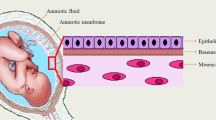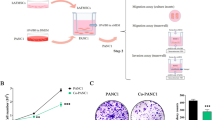Abstract
High-grade gliomas are difficult to treat. We examined the therapeutic effect of intratumoral administration of human amniotic membrane derived-mesenchymal stem cells (hAMCs) on the growth of gliomas. Tumor volume of the control group was 1632 ± 316 mm3 on day 30, and the group treated with a single intratumoral dose of hAMCs had a tumor volume of 1128 ± 269 mm3 (P < 0.05). Thus, administration of hAMCs significantly reduced tumor size. In rat glioma tissues treated with single and multiple dosages of hAMCs, there was a reduction in tumor volume of approximately 30.9 and 49.5%, respectively. We further evaluated the glioma tissue using Western blotting analysis and observed that the expression of Bax, caspase-8 and caspase-3 were greatly increased and the expression of Bcl-2 was greatly decreased in tumors treated with hAMCs. Sections of nude mice treated with hAMCs clearly showed the presence of an increase in apoptotic cells. The data collected herein confirms for the first time that hAMCs can inhibit C6 glioma growth and induce apoptosis of C6 gliomas in vivo. This demonstrates that hAMCs are a potential new therapeutic agent for the treatment of gliomas.
Access this article
We’re sorry, something doesn't seem to be working properly.
Please try refreshing the page. If that doesn't work, please contact support so we can address the problem.







Similar content being viewed by others
References
Donato V, Papaleo A, Castrichino A, Banelli E, Giangaspero F, Salvati M, Delfini R (2007) Prognostic implication of clinical and pathologic features in patients with glioblastoma multiforme treated with concomitant radiation plus temozolomide. Tumori 93(3):248–256
Kang SG, Kim JH, Nam DH, Park K (2005) Clinical and radiological prognostic factors of anaplastic oligodendroglioma treated by combined therapy. Neurol Med Chir (Tokyo) 45(5):232–238 discussion 238-9
Desjardins A, Quinn JA, Vredenburgh JJ, Sathornsumetee S, Friedman AH, Herndon JE, McLendon RE, Provenzale JM, Rich JN, Sampson JH, Gururangan S, Dowell JM, Salvado A, Friedman HS, Reardon DA (2007) Phase II study of imatinib mesylate and hydroxyurea for recurrent grade III malignant gliomas. J Neurooncol 83(1):53–60
Scheda A, Finjap JK, Tuettenberg J, Brockmann MA, Hochhaus A, Hofheinz R, Lohr F, Wenz F (2007) Efficacy of different regimens of adjuvant radiochemotherapy for treatment of glioblastoma. Tumori 93(1):31–36
Mannello F, Tonti GA, Bagnara GP, Papa S (2006) Role and function of matrix metalloproteinases in the differentiation and biological characterization of mesenchymal stem cells. Stem Cells 24(3):475–481
Laflamme MA, Murry CE (2005) Regenerating the heart. Nat Biotechnol 23(7):845–856
Zhao P, Ise H, Hongo M, Ota M, Konishi I, Nikaido T (2005) Human amniotic mesenchymal cells have some characteristics of cardiomyocytes. Transplantation 79(5):528–535
Ochsenbein-Kölble N, Bilic G, Hall H, Huch R, Zimmermann R (2003) Inducing proliferation of human amnion epithelial and mesenchymal cells for prospective engineering of membrane repair. J Perinat Med 31(4):287–294
Kang SG, Jeun SS, Lim JY, Kim SM, Yang YS, Oh WI, Huh PW, Park CK (2008) Cytotoxicity of human umbilical cord blood-derived mesenchymal stem cells against human malignant glioma cells. Childs Nerv Syst 24(3):293–302
Kim DS, Kim JH, Lee JK, Choi SJ, Kim JS, Jeun SS, Oh W, Yang YS, Chang JW (2009) Overexpression of CXC chemokine receptors is required for the superior glioma-tracking property of umbilical cord blood-derived mesenchymal stem cells. Stem Cells Dev 18(3):511–519
Kim SM, Lim JY, Park SI, Jeong CH, Oh JH, Jeong M, Oh W, Park SH, Sung YC, Jeun SS (2008) Gene therapy using TRAIL-secreting human umbilical cord blood-derived mesenchymal stem cells against intracranial glioma. Cancer Res 68(23):9614–9623
Dasari VR, Velpula KK, Kaur K, Fassett D, Klopfenstein JD, Dinh DH, Gujrati M, Rao JS (2010) Cord blood stem cell-mediated induction of apoptosis in glioma downregulates X-linked inhibitor of apoptosis protein (XIAP). PLoS One 5(7):e11813
Reed JC (2000) Mechanisms of apoptosis. Am J Pathol 157(5):1415–1430
Euhus DM, Hudd C, LaRegina MC, Johnson FE (1986) Tumor measurement in the nude mouse. J Surg Oncol 31(4):229–234
Tomayko MM, Reynolds CP (1989) Determination of subcutaneous tumor size in athymic (nude) mice. Cancer Chemother Pharmacol 24(3):148–154
Secchiero P, Zorzet S, Tripodo C, Corallini F, Melloni E, Caruso L, Bosco R, Ingrao S, Zavan B, Zauli G (2010) Human bone marrow mesenchymal stem cells display anti-cancer activity in SCID mice bearing disseminated non-Hodgkin’s lymphoma xenografts. PLoS One 5(6):e11140
Wei Z, Chen N, Guo H, Wang X, Xu F, Ren Q, Lu S, Liu B, Zhang L, Zhao H (2009) Bone marrow mesenchymal stem cells from leukemia patients inhibit growth and apoptosis in serum-deprived K562 cells. J Exp Clin Cancer Res 28:141
Khakoo AY, Pati S, Anderson SA, Reid W, Elshal MF, Rovira II, Nguyen AT, Malide D, Combs CA, Hall G, Zhang J, Raffeld M, Rogers TB, Stetler-Stevenson W, Frank JA, Reitz M, Finkel T (2006) Human mesenchymal stem cells exert potent antitumorigenic effects in a model of Kaposi’s sarcoma. J Exp Med 203(5):1235–1247
Han X, Meng X, Yin Z, Rogers A, Zhong J, Rillema P, Jackson JA, Ichim TE, Minev B, Carrier E, Patel AN, Murphy MP, Min WP, Riordan NH (2009) Inhibition of intracranial glioma growth by endometrial regenerative cells. Cell Cycle 8(4):606–610
Brunelle JK, Letai A (2009) Control of mitochondrial apoptosis by the Bcl-2 family. J Cell Sci 122(Pt 4):437–441
Zander T, Kraus JA, Grommes C, Schlegel U, Feinstein D, Klockgether T, Landreth G, Koenigsknecht J, Heneka MT (2002) Induction of apoptosis in human and rat glioma by agonists of the nuclear receptor PPARgamma. J Neurochem 81(5):1052–1060
Yip KW, Reed JC (2008) Bcl-2 family proteins and cancer. Oncogene 27(50):6398–6406
Hassouna I, Wickert H, Zimmermann M, Gillardon F (1996) Increase in Bax expression in substantia nigra following 1-methyl-4-phenyl-1, 2, 3, 6-tetrahydropyridine (MPTP) treatment of mice. Neurosci Lett 204(1–2):85–88
Yin C, Knudson CM, Korsmeyer SJ, Van Dyke T (1997) Bax suppresses tumorigenesis and stimulates apoptosis in vivo. Nature 385(6617):637–640
Antonsson B, Montessuit S, Lauper S, Eskes R, Martinou JC (2000) Bax oligomerization is required for channel-forming activity in liposomes and to trigger cytochrome c release from mitochondria. Biochem J 345(Pt 2):271–278
Desagher S, Martinou JC (2000) Mitochondria as the central control point of apoptosis. Trends Cell Biol 10(9):369–377
Adams JM, Cory S (2001) Life-or-death decisions by the Bcl-2 protein family. Trends Biochem Sci 26(1):61–66
Acknowledgments
This study was supported by the Program for New Century Excellent Talents in University (No. NECT-06-0611), Three Key Disciplines Construction Project of Zhengzhou University 211 Project, and the Henan Province Medical Technological Innovation Project (No. 2005018).
Conflict of interest
None.
Author information
Authors and Affiliations
Corresponding author
Additional information
Hongliang Jiao and Fangxia Guan are contributed equally to this study.
Rights and permissions
About this article
Cite this article
Jiao, H., Guan, F., Yang, B. et al. Human amniotic membrane derived-mesenchymal stem cells induce C6 glioma apoptosis in vivo through the Bcl-2/caspase pathways. Mol Biol Rep 39, 467–473 (2012). https://doi.org/10.1007/s11033-011-0760-z
Received:
Accepted:
Published:
Issue Date:
DOI: https://doi.org/10.1007/s11033-011-0760-z




